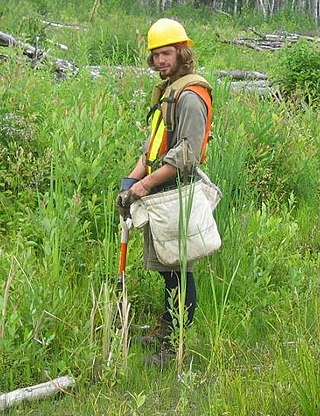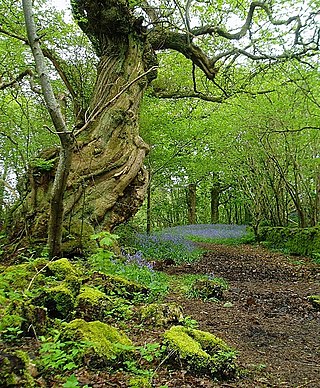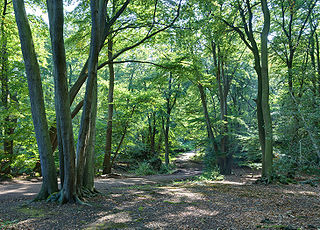The Great Northumberland Forest is a proposed new forest in the north of England. Announced in September 2019, it is intended that up to a million trees will be planted between 2020 and 2024.
Contents

The Great Northumberland Forest is a proposed new forest in the north of England. Announced in September 2019, it is intended that up to a million trees will be planted between 2020 and 2024.

The Great Northumberland Forest [1] was announced by Secretary of State for Environment, Food and Rural Affairs Theresa Villiers at the Conservative Party Conference on 27 September 2019. It was part of a package of measures that were presented as leading to a carbon-neutral United Kingdom by 2050. The plans had been championed by the Member of Parliament for Hexham, Guy Opperman, who stated that the proposed forest would help absorb carbon dioxide from the atmosphere, increase the provision of green space in the region for recreational purposes and provide the nucleus for a new forestry/timber industry. [2] The scheme was welcomed by Greenpeace but they noted that it was only a fraction of the 700 million new trees that they say need to be planted before 2030. [3]
It is not intended to be one new forest block, but rather a more wooded county generally. However, the project does start with three sites. It is intended that up to one million trees will be planted across 500 hectares (1,200 acres) of land in Northumberland between 2020 and Spring 2024. [2] [4] A variety of tree types will be planted in the forest, rather than solely conifers which have been used in other new forest schemes. [3] A new organisation, the Northumberland Woodland Creation Partnership, has been established to assist local residents, landowners and environmental groups to plan for the woodland creation. [2] The forest will initially be planted at three sites on government-owned or newly acquired land. [2] [4] The Forestry Partnership will then look to expand the forest by identifying new sites suitable for afforestation, of which there is an estimated 120,000 hectares (300,000 acres) in the county. [4] [5]
Planting was timed to start ahead of the UN Climate Change Conference (COP26), which was scheduled to take place in Glasgow in November 2020 [5] [6] before its postponement to November 2021. [7]
It was in the Conservative manifesto for the 2019 United Kingdom general election. [8]
The Great Northumberland Forest area is adjacent to the North East Community Forest, [9] which includes the local authorities of Tyne and Wear as well as Durham County Council.
By May 2020 Forestry England had started planting Rushy Knowe, a new 145 hectares (360 acres) forest on the banks of Kielder Water. That same month it announced the purchase of 100 hectares (250 acres) of land at Monkridge, West Woodburn for the second of three sites. The third site has not yet been announced. [10]
Between the announcement in 2019 and the 2023-2024 planting season, it is calculated that over 932 hectares (2,300 acres) of woodland has been created, plus over 2.9 million individual trees in smaller schemes (hedgerow trees, individual trees e.g. in parkland style). [11] This includes tree establishment funded through Countryside Stewardship, The Woodland Carbon Fund / The Woodland Carbon Code, the Northumberland Wildlife Trust, the Rivers Trusts in the county, Farming in Protected Landscape funding, the Green Recovery Challenge Fund, and trees planted as part of planning applications.
A launch event was held at Kirkharle in November 2021. [12] "Great Northumberland Forest Launch" on YouTube

A forest is an ecosystem characterized by a dense community of trees. Hundreds of definitions of forest are used throughout the world, incorporating factors such as tree density, tree height, land use, legal standing, and ecological function. The United Nations' Food and Agriculture Organization (FAO) defines a forest as, "Land spanning more than 0.5 hectares with trees higher than 5 meters and a canopy cover of more than 10 percent, or trees able to reach these thresholds in situ. It does not include land that is predominantly under agricultural or urban use." Using this definition, Global Forest Resources Assessment 2020 found that forests covered 4.06 billion hectares, or approximately 31 percent of the world's land area in 2020.

Forestry is the science and craft of creating, managing, planting, using, conserving and repairing forests and woodlands for associated resources for human and environmental benefits. Forestry is practiced in plantations and natural stands. The science of forestry has elements that belong to the biological, physical, social, political and managerial sciences. Forest management plays an essential role in the creation and modification of habitats and affects ecosystem services provisioning.

Reforestation is the practice of restoring previously existing forests and woodlands that have been destroyed or damaged. The prior forest destruction might have happened through deforestation, clearcutting or wildfires. Three important purposes of reforestation programs are for harvesting of wood or for climate change mitigation, and ecosystem and habitat restoration purposes. One method for reforestation is to establish tree plantations, also called plantation forests. They cover about 131 million ha worldwide, which is 3% of the global forest area and 45% of the total area of planted forests.

The Woodland Trust is the largest woodland conservation charity in the United Kingdom and is concerned with the creation, protection, and restoration of native woodland heritage. It has planted over 50 million trees since 1972.
The Forestry Commission is a non-ministerial government department responsible for the management of publicly owned forests and the regulation of both public and private forestry in England.

Tree planting is the process of transplanting tree seedlings, generally for forestry, land reclamation, or landscaping purposes. It differs from the transplantation of larger trees in arboriculture and from the lower-cost but slower and less reliable distribution of tree seeds. Trees contribute to their environment over long periods of time by providing oxygen, improving air quality, climate amelioration, conserving water, preserving soil, and supporting wildlife. During the process of photosynthesis, trees take in carbon dioxide and produce the oxygen we breathe.

The National Forest is an environmental project in central England run by The National Forest Company. From the 1990s, 200 square miles (520 km2) of north Leicestershire, south Derbyshire and southeast Staffordshire have been planted in an attempt to blend ancient woodland with newly planted areas to create a new national forest. It stretches from the western outskirts of Leicester in the east to Burton upon Trent in the west, and is planned to link the ancient forests of Needwood and Charnwood.

In the United Kingdom, ancient woodland is that which has existed continuously since 1600 in England, Wales and Northern Ireland. Planting of woodland was uncommon before those dates, so a wood present in 1600 is likely to have developed naturally.

Afforestation is the establishment of a forest or stand of trees in an area where there was no recent tree cover. In comparison, reforestation means re-establishing forest that have either been cut down or lost due to natural causes, such as fire, storm, etc. There are three types of afforestation: Natural regeneration, agroforestry and tree plantations. Afforestation has many benefits. In the context of climate change, afforestation can be helpful for climate change mitigation through the route of carbon sequestration. Afforestation can also improve the local climate through increased rainfall and by being a barrier against high winds. The additional trees can also prevent or reduce topsoil erosion, floods and landslides. Finally, additional trees can be a habitat for wildlife, and provide employment and wood products.

The Thames Chase Community Forest is a community forest of 9842 hectares located in 47 sites in London and Essex, England. Established in 1990, the community forest is administered by the Thames Chase Trust, with a stated aim "to renew and regenerate the landscape at the edge of East London and South Essex by creating a varied wooded landscape for local people to influence, create, use, enjoy and cherish".
Forest management is a branch of forestry concerned with overall administrative, legal, economic, and social aspects, as well as scientific and technical aspects, such as silviculture, forest protection, and forest regulation. This includes management for timber, aesthetics, recreation, urban values, water, wildlife, inland and nearshore fisheries, wood products, plant genetic resources, and other forest resource values. Management objectives can be for conservation, utilisation, or a mixture of the two. Techniques include timber extraction, planting and replanting of different species, building and maintenance of roads and pathways through forests, and preventing fire.

Kielder is a small, remote village in western Northumberland, England. Located at the head of Kielder Water and in the north west of Kielder Forest, the village is within three miles of the Scottish border.

Bedford Purlieus is a 211-hectare (520-acre) ancient woodland in Cambridgeshire, in the United Kingdom. It is a national nature reserve and Site of Special Scientific Interest owned and managed by the Forestry Commission. In Thornhaugh civil parish, 10 km (6.2 mi) south of Stamford and 14 km (8.7 mi) west of Peterborough, the wood is within the Peterborough unitary authority area of Cambridgeshire, and borders Northamptonshire. In Roman times it was an iron smelting centre, during the medieval period it was in the Royal Forest of Rockingham, and later it became part of the estates of the Duke of Bedford. Bedford Purlieus appears to have been continuously wooded at least from Roman times, and probably since the ice receded. The woodland may have the richest range of vascular plants of any English lowland wood. It acquired particular significance in the 1970s as an early subject for the historical approach to ecology and woodland management.

The United Kingdom, being in the British Isles, is ideal for tree growth, thanks to its mild winters, plentiful rainfall, fertile soil and hill-sheltered topography. In the absence of people, much of Great Britain would be covered with mature oaks, except for Scotland. Although conditions for forestry are good, trees face threats from fungi, parasites and pests. Nowadays, about 13% of Britain's land surface is wooded. European countries average 39%, but this varies widely from 1% (Malta) to 66% (Finland). As of 2021, government plans call for 30,000 hectares to be reforested each year. Efforts to reach these targets have attracted criticism for planting non-native trees, or trees that are out of place for their surroundings, leading to ecological changes.
Heartwood Forest is a planned forest in Hertfordshire, England. The site covers 347 hectares, the largest continuous new native forest in England.

Scotland is ideal for tree growth, thanks to its mild winters, plentiful rainfall, fertile soil and hill-sheltered topography. As of 2019 about 18.5% of the country was wooded. Although this figure is well below the European Union (EU) average of 43%, it represents a significant increase compared to the figure of 100 years previously: in 1919 it was estimated that only 5% of the country's total land area was covered in forest. The Scottish Government's Draft Climate Change Plan has set an aim of increasing coverage to 21% of Scotland by 2032, with the rate of afforestation rising to 15,000 hectares per year by 2024.

Upper Wye Gorge is a Site of Special Scientific Interest (SSSI), noted for its biological and geological characteristics, around Symonds Yat in the Wye Valley on the Wales–England border. The site is listed in the 'Forest of Dean Local Plan Review' as a Key Wildlife Site (KWS).
Forestry England is a division of the Forestry Commission, responsible for managing and promoting publicly owned forests in England. It was formed as Forest Enterprise in 1996, before devolving to Forest Enterprise England on 31 March 2003 and then being rebranded to Forestry England on 1 April 2019.
Afforestation efforts in Scotland have provided an increase in woodland expansion. By the 20th century mark, Scotland had diminished woodland coverage to 5% of Scotland's land area. However, by the early 21st century, afforestation efforts have increased woodland coverage to 17%. The Scottish government released their Draft Climate Change Plan in January 2017. The 2017 draft plan has increased the targeted woodland coverage to 21% by 2032 and increases the afforestation rate to 15,000 hectares per year.